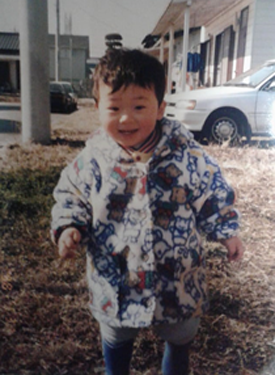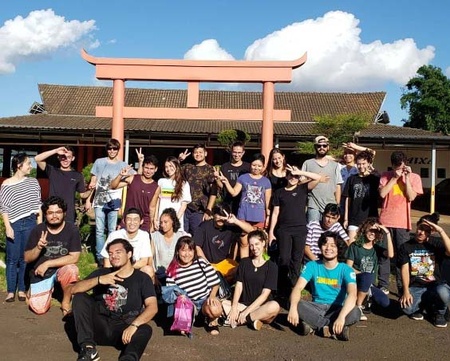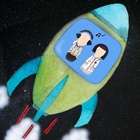On the paternal side, his great-grandfather’s parents came from the Hokkaido Prefecture and his great-grandmother’s from Gunma. On his mother’s side, his great-grandfather’s parents were from Miyagi and his great-grandmother’s from Yamaguchi and Hiroshima. These are the family origins of the 25-year-old Yonsei Douglas Mitsuyuki Ito, who holds a degree in Information Technology Management.
Family culture

“I feel that up until my grandparents’ generation there was a very strong Japanese cultural presence, with the practice of Buddhism and old customs, as well as the use of the language,” Douglas says. He adds that his paternal grandparents have always been involved—and remain involved—in Japanese cultural associations (kaikan). His maternal grandmother, for her part, belonged to a taiso group. Speaking of Bachan, the grandson still remembers having Japanese rice with pinto beans for lunch at her place. These days, the family “mixes Japanese and Brazilian dishes so we can have more food without losing too much of the flavor.”
The influence of traditions was milder in his parents’ generation, which had different religions, more mixing with other cultures, and basic-level Japanese. “That generation also had the opportunity to live in Japan for some time; so I was born there, in the town of Ryugasaki, Ibaraki-ken,” he explains.
The families of both his mother and his father are from Mogi das Cruzes, São Paulo state (SP). During his youth, his parents and their siblings took part in activities at the kaikan. “On my father’s side, since my grandparents are very active at the Cultural and Agricultural Association of Biritiba Ussu [community in the outskirts of Mogi das Cruzes] (ACABU), my uncles continue to attend events like the undokai.”
The young technologist says that he has an aunt living in Japan, adding that she helped him a lot when, through a scholarship, he attended a JICA (Japan International Cooperation Agency) course in July and August 2019. “It was incredible!” Most of that time he stayed in Yokohama, though he also traveled to Kyoto. “And in my free time I even got to visit the city where I was born and the street where I lived. I really want to have the chance to go back.” [Laughs.]
Customs and values
Taking off your shoes when entering the house and eating with chopsticks are some of the typical customs that his family has preserved. “I studied a little bit of nihongo, but I had to stop because of my schedule,” he says.
Among the most important values he has been and continues to be exposed to is that of discipline. “But I only got to develop real ‘values’ when I became involved in the kaikan”; for instance, the omotenashi (the act of providing the best possible experience to a guest at one’s home, to those around us, or to a client). Another example is avoiding waste (mottainai), which “in a way ends up being controversial when it comes to letting food/goods go bad.” [Laughs.]
“For me, it’s more a matter of rediscovering Japanese culture or even getting to truly understand what Brazilian culture is.” Since his grandparents provided him with a cultural foundation, from his adolescence onwards he gradually became more interested and his understanding deepened. “Especially after the JICA course, I had much more insight on how rich this culture is.”
Commitment to the Nikkei community
“At the core of my commitment to the community are the Central Japanese-Brazilian Association of the Bragantina Region [SP], the Seinen League, and the Brazilian Society of Japanese Culture and Social Welfare—Bunkyo,” notes the Nikkei leader.
The Bragança Paulista (SP) Seinen.
“I only got to know the community up close when I was 16, in 2013,” when a friend invited him to become a volunteer at the Bragança Paulista Japan Festival, which had its first edition in 2008 with the celebration of the centenary of Japanese immigration to Brazil.
From then on, he became a permanent member of the Seinenkai (youth group) in Bragança, and participated in the creation of Anime Nipo (at the Seinen itself) and in several youth integration events, among them Movimente, belonging to the Nippon Country Club of Arujá (SP), and Union, Friendship and Interaction (UAI), belonging to the Belo Horizonte-based Japanese-Brazilian Cultural Association of Minas Gerais [the state of Minas Gerais borders the Bragantina Region].
In 2014 he assumed the presidency of the group until the following year. He returned as vice president in 2017–18 in order to support the new leaderships and ended this presidential journey in 2020–21. Today he is the Director of Events and Marketing, in addition to performing the role of Secretary and handling financial affairs.
Although Douglas continues to work with young people, the reality is that turnover is very high. For instance, among the participants are pre-college students looking for public colleges; as a result, a good number of them are gone after spending two or three years taking part in the activities. There are also those who leave because of work, or because they believe they have had enough experiences as members of the group, or they have other priorities, or the commute/distance becomes an issue. In all these years, “I’ve had the opportunity to see many different generations of young people.”
Seinen League
“Now, what do I do next?” That was the question he asked himself after ending his first stint as president of the Bragança Seinen in 2016. He then participated in the União Seinen Brasil (USB), an initiative whose aim was to keep track of and provide support for Nikkei youth groups, but that shortly afterwards ceased to exist. That was when the idea of the Seinen League was born.
The Seinen League is an independent movement; there is no headquarters or connection to any association. “I founded it with some friends in November 2018 because at that time there was no national movement with the goal of creating and maintaining a network of contacts among the seinen,” he recalls.
In their first year, they developed a website (ligaseinen.com), created social network profiles, and began to invite other youth groups to join in. The requirements consist of opening an account; providing the necessary information, e.g., the name of the association, the name of its current president, and the city where it's located; and agreeing to the terms and conditions of the movement. The entities that become part of the League are called “linked entities.”
Later on, in 2019, the group held an online League of Legends tournament and participated in events geared to youth leadership groups like REVI and Boost, the latter from the Seinenkai Nipo Campinas [SP].
In 2020, he formed caravans to attend in-person meetings in the cities of Bragança Paulista and Sumaré (SP). But then the pandemic broke out and, to remain active, he transferred his focus to online activities: game nights, movie presentations, chess workshops, etc. In addition, he provided support for several online events throughout the year. Many of these were held thanks to the assistance of [the association] Nipo Bragança, which allowed the use of services like Zoom Premium, a platform with a plan that includes sessions with no time limits.
In November 2021, the “linked youths” promoted the movement’s three-year anniversary party through an even bigger partnership sealed with the Bragança association, which provided space and equipment for a special live event.
That same year, he became a REVI (Revitalization—National Forum of Young Organization Leaders) supporter. Their event was held virtually by the Bunkyo Seinen.
“The plan is that little by little we’ll be creating more partnerships, encompassing more events.” In 2022 they were going to stage a youth integration (exchange) event along with the Nipo Bragança; however, they were afraid to proceed following a Covid-19 outbreak in June. “Who can tell what the future holds for us?” [Laughs.]
Of course, Douglas thinks about the League’s future: he wants to go back to dedicating himself to the initiative. “The Seinen League is the way I found for me to repay everything the community has offered me in terms of knowledge, friendships, networking, and everything else.” The expectation is that, as a result of all this effort and determination, the leadership in the Japanese-Brazilian community will recognize the League as an important and influential movement. The challenges now are time, mostly, and people.
Bunkyo
Near the end of 2013, the Bragança Seinen was invited to attend a REVI event, but getting there turned out to be a problem. For that reason, the first event he helped to organize was the Bunkyo Integration Forum (FIB), held by the Bunkyo Youth Committee and made up of various commissions, among them the Bunkyo Youth Commission (CJB). “Later on, I began to participate in REVI events; I was part of the Bunka Matsuri (Bunkyo’s Japanese Culture Festival) commission and I volunteered at the Sakura Matsuri (Cherry Blossom Festival).”
More recently, in 2021, he joined the CJB. In 2022, he became Project Director: “I try to help in any way I can, even from a distance. What’s cool is that so much is handled online.”
Image, discrimination, and changes
While attending elementary school in 2000, he moved from the capital city of São Paulo to Bragança Paulista, located 67 km away. At first, he felt pretty out of place as they noticed he was “different.” However, he soon realized that it was actually a matter of “finding the right tribe,” and in fact he would end up making “good friendships.” But for some time, Douglas felt the burden of the Japanese stereotype of academic excellence. Later on, in high school, he stopped putting pressure on himself in that regard.
Major changes can be noticed in how the purpose of Japanese cultural organizations is viewed. “I understand that the Issei and Nisei felt a very strong need to remain united and to protect one another. The kaikan was the place where the community’s day-to-day activities were held, from education—the teaching of Nihongo—to sports and club activities, etc.” He adds: “today there is no such need to ‘protect the community,’ since at this time the Japanese-Brazilian culture is already pretty well established. So this has led to some generational conflicts and no one understands why. Priorities and values have changed a lot according to each generation.”
“When it comes to ‘modern’ prejudices, I think there’s more of a fetish than prejudice,” he says, asserting that’s a consequence of the expansion of [Japanese] pop culture and the Internet—manga, anime, dance groups (including Korean ones), doramas, etc. “Anyway, all this and more have brought different perspectives and Asian portrayals.” Since those of Japanese ancestry are now integrated into Brazilian society, even if through a distorted prism, “our current role is to contribute to society as a whole.” In other words, the Yonsei veteran believes that he does his part through his work at cultural organizations, while focusing on empowering young people so as to prepare them to hold future leadership positions.
Yonsei, yes
Douglas considers himself a Yonsei for several reasons. The first one is the “historical distance” separating him from his great-grandparents and their culture, as he has “neither the imperialist sentiment of the Issei nor the bitterness of the Nisei (many of whom went through difficulties during the war), nor the transition, amplification, and greater diffusion of the Sansei.” He adds: “I did have my own experiences, but they were certainly very different from those of the Issei and Nisei.”
Nikkei identity
The young descendant of Japanese immigrants ponders on what it means to be Nikkei. When one talks about the Nikkei community, what automatically comes to mind are groups and organizations that carry out activities related to Japanese culture. “And who are the people involved? Could all of them be Japanese? Well, no. Nikkei, then, is anyone who is in some way committed, contributing to the culture.”
“We’re here to mold society, whether in Brazil or around the world, and to contribute to this cultural hodgepodge that we have,” he says. And he thinks it’ll all be worthwhile in case they succeed in combining the positive characteristics of each culture and, consequently, “build a better society.”
© 2022 Tatiana Maebuchi







